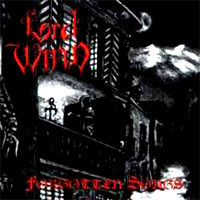Lord Wind - Forgotten Songs
Review: As black metal wound down in the mid-1990s, some musicians wanted the spirit to live on, and realizing that the surface elements of black metal would rapidly be cloned, they transitions to new styles that generally went to black metal's deepest non-metal influences: ambient music and soundtracks. With artists like Tangerine Dream and Kraftwerk the admitted influences on artists like Darkthrone, Burzum and Celtic Frost, the pathway had a firm foundation but no voice. Replacing the surfacing of black metal would take additional generations going on behind the scenes.
For those familiar with later Lord Wind -- a hybrid of synthpop, neofolk, "Conan the Barbarian" soundtracks and the epic gothic medievalist music of Dead Can Dance -- the earliest effort from this band may seem confused in style. Borrowing much from the contemporary Graveland release Following the Voice of Blood, the first Lord Wind album uses undistorted guitars under moaning, strangled vocals with an ear for medieval and baroque melody as if adapted into a folk song. This ambitious approach falls short on this album because having both the epic grandeur of metal and its post-human focus as well as using metal instrumentation both excludes anything but rock or folk-styled vocals, and limits the music to one dominant melodic voice if monotone vocals are used.
Forgotten Songs uses martial drums to guide its guitar melodies but does not fill the space it sets out to and so ends up being repetitive, and as the songwriter reacted to this and became unsure of how to flesh it out, confused, more like the sparse but hollow Immortal Pride from Graveland in the same year of this release. Similar to the folk stylings of neofolk but without the punk-influenced energies or attempts to pander to the individual, this album barely manages to hold on to what makes metal "metal," which is a perspective that rotates away from the individual to a landscape in which ideas and demographics collide.
Simple melodies that show the influence of folk songs in the Celtic and Slavonic traditions, many relying on downward arpeggiation, cycle past but fail to connect to a larger songwriting framework, so the music sounds fragmentary and lost. The groaning, gurgling vocals occur almost independently, and wind noises and periodic martial-industrial influences filter through, but cannot bolster the inability of this album to meld style and content. It's probably best to focus on later Lord Wind works for the completion of this idea through the use of multiple melodic voices and, through layers and more complex song structures, the fulfilment of its promise.

